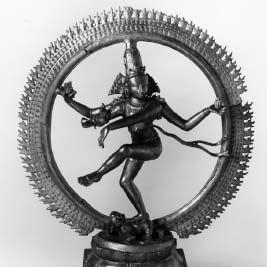HinduismSigns and Symbols |
What are some basic clues about the iconography of the major deities? |
Walk through the Asian galleries of your local museum, or visit a Hindu temple, and chances are good that you will spot some of the following images. Shiva’s main symbol is the short pillar-like object called the linga which, together with the female yoni, represents divine creative power. But you may also find Shiva Nataraja (“Dance King”) surrounded by a ring of fire (cosmic flux) and trouncing the demon of ignorance. His upper right hand holds the drum whose sound is that of creation, his upper left the fire of destruction. His lower left points to the earth, the lower right raised in a gesture of reassurance. From his head flows the Ganges, whose fall to Earth Shiva breaks with his matted locks. You may find his beloved mount, the bull Nandi, nearby. Shiva may also appear seated with his very voluptuous wife, Parvati, and their very human-looking son Skanda. There Shiva will hold an axe and a deer as symbols of his lordship over nature. You may also see the combined male and female Shiva-Parvati called “Half-woman Lord.” Their other son, Ganesha, is the one with the elephant head and pot belly. He holds a bowl of sweets in one hand, and in the other one of his own tusks, which he is about to hurl at the demon who made fun of him. His vehicle is a mouse or rat, an obvious dash of humor. Vishnu may appear alone or with his wife, Lakshmi. He typically carries the conch shell (capable of making a world-shuddering sound), the discus (a weapon for cutting enemies off at the knees), and the mace, while raising a fourth hand in reassurance. Vishnu’s most popular avatar, Krishna, frequently plays his world-charming flute, with his legs crossed jauntily in a dance step. His beloved Radha often appears with him. Rama is the second most important avatar, recognizable by his bow when standing alone, but usually seen in company of his wife Sita, his brother Lakshmana, and their faithful monkey assistant Hanuman.

Shiva Nataraja (“Dance King”), Chola Period, twelfth century, South India, bronze. His upper right hand holds the drum of creation, his upper left the fire of destruction. With his lower right hand he makes a gesture of reassurance, while his lower left points to the earth, where his left foot tramples on the demon of ignorance. The circle of flame recalls the world in flux. (Courtesy of the St. Louis Art.)
